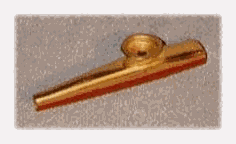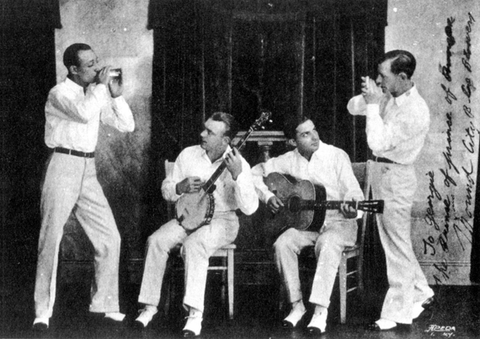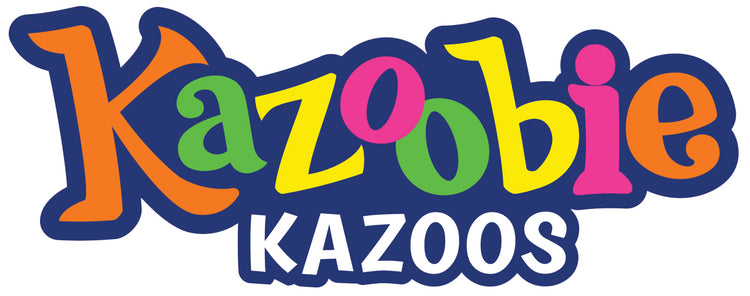The Kazoo - Its "physics", history, and importance for modern music
The text of a speech by Michael Fink of Denmark.
Appearance:
A kazoo is a tube-formed, American musical instrument, with both ends of
the tube uncovered.
One end of the tube is flattened, while the other end of the tube has a
small circular opening.
Around two thirds down the instrument there is another circular hole.
This hole leads to a small chamber, where a wax-membrane is situated.
The membrane, which is fixed around the edges by a circular
cylinder-ring, is free to oscillate.
A kazoo may be made out of plastic or metal and can have all sorts of
different shapes.
How to play the kazoo:
The whole idea behind the instrument is, that a kazoo player by singing
or speaking through the instrument induces an air current which makes
the membrane vibrate and thus creates a summing, "nasal" sound.
By wholly or partially covering up the membrane hole a great diversity
of sounds are created.
The membrane is the key point of the kazoo. This membrane gives the
kazoo its distinction from the "horn-section-instruments". The kazoo
should be viewed as a singing-drum.
Therefore it is of no use to simply blow through a kazoo, which is a
common mistake among first time kazoo-users.
Further it is not recommended to make a hole in the membrane, since this
ruins the instrument, and shows ones lack of understanding the
physics of the kazoo.
The ancient ancestors of the kazoo:
The kazoo is categorised among the type of instruments known as the
"mirlitons".
This group of instruments are characterised by having a vibrating
membrane.
It is believed that the kazoos closest relative is the African version of
a mirliton: the horn-mirliton. The building materials of the
horn-militon were of a more primitive nature. The tube was made out of
the horn of a cow and the membrane consisted of the egg-shells of
spiders.
The African horn-mirliton was used to distort voices at tribe
gatherings. An analogy here is the use of the mask in the theatre.
The first mirlitons in Europe were the "eunuk"-flutes from 17th and
18th century.
König Ludwig von Bayern had an enormous 2.13 meter long mirliton build
for use in a Wagner opera. To construct this mirliton the king imported
extremely "fat" eunuks from the kingdom of Ottoman to do the job.
The kazoo becomes a thing of the common people:
Through the 18th hundreds instruments of different construction but
similar to the kazoo could be found in the major part of North-America.
These instruments were based on the African mirliton and were used for
folk music.
In the mid-18th hundreds the kazoo in its present form started making an
impact on the history of the world.
A guy by the name of Alabama Vest got the idea for the kazoo in the
1840's in Macon, Georgia. He teamed up with the German clock
manufacturer Thaddeus Von Glegg to construct the first kazoo.
Emil Sorg, who was a travelling salesman, came across a Vest and von Glegg's
kazoo on one of his business trips. He showed great interest
in the kazoo and was eager to get the kazoo into mass-production.
With this thought in mind Emil Sorg travelled to New York. Here he
became partners with Michael McIntyre, who was an iron smith. Together
Sorg and McIntyre created the first production of the kazoo in the year
1912.
McIntyre had now gained enough knowledge to maintain the production of kazoos
all by himself. All he needed was a larger factory. In 1913 he separated from Emil Sorg
and teamed up with Harry Richardson who owned a big metal factory.
McIntyre and Richardson launched the first mass-production of the kazoo in 1914.
Selling kazoos was a good business. The salesfigures of the popular instrument rose enormously.
In 1916 McIntyre and Richardson renamed their partnership and turned it into a company
called The Original American Kazoo Company.
As other manufacturers of kazoos tried to get in on the sales market the pressure of
competition was rising. Therefore it was a feeling of satisfaction and pride when McIntyre
succeded to get his product patented in 1923.
The factory itself still exists today and it still produces kazoos. Next to the the original
factory a museum has been built to tell the history of the kazoo and to give a detailed description
of the manufacturing process.
The different disguises of the kazoo:
The looks of a kazoo can vary a lot. Depending on the size of the membrane hole
and the shape of the kazoo all sorts of musical instruments can be imitated.
The Soprano Kazoo- the size of a standard kazoo, can bring out the highest pitch, flute.

The Alto Kazoo- 15 cm, imitating the sound of a clarinet and a trumpet.

The Tenor kazoo- 30 cm, saxophon.
The Bariton Kazoo- 46cm, french horn og jagdhorn.
The Kaboom Kazoo- 90cm, a membran diameter of 12,5cm, tuba.
The impact of the kazoo on the history of music:
Jazz:
The jazz group The Mound City Blue Blowers- world history´s first recording with a kazoo.
The group gathered in 1923 in St. Louis.
Red McKenzie- primus motor, comb and paper, vocal.
Dick Slevin- kazoo, other homemade instruments.
Jack Bland- banjo, guitar.
We will listen to the song "San", recorded the 14.3.1924 in Chicago.
The groups debut record "Arkansaw Blues" was purchased by over 1 million people!
Listen closely to the first solo- it’s Dick Slevin on kazoo.

Blues:
The dixieland group Memphis Jug Band.
Will Shade- guitar, harmonica.
Will Weldon- guitar.
Unknown- kazoo, jug, vocal.
We will listen to the tune "Newsport News Blues" and
the kazoo-solo from "Sun Brimmers Blues", because it’s funny.
Both songs are recorded the 24.2.1927.
The Blues guitarist Robert Pete Williams who grew up un a cotton farm
and worked his back to pieces uses the kazoo in some of his songs. It’s his brother
Big Add Joe on kazoo. Robert Pete Williams had a hard life and was sentenced prison
for life for a murder he didn’t commit. This fact surely influenced his way of approaching
the blues. We will listen to the song "She walked around with her mouth poked"
recorded the 20th of march 1972 in Copenhagen.
Also the world wide famous rock/blues artist Eric Clapton uses the kazoo on his
cover version of "San Francisco Bay Blues" taken from his
"Unplugged" record from 1991. His kazoo solo is not particularly
special but it fits well to athmossphere of the song. The song was originally written
by the blues guitarist Tampa Red who often used the kazoo in his songs.
Danish music:
Poul Dissings "Jeg har en flyvemaskine" ("I have an aeroplane")
brings out memories from our childhood when we played with toys and the world was
wherever Mom was. At that time we didn’t realise that we listened to the Danish
kazoo-guru Freddy Fræk who accompanies Poul Dissing. For many years
Freddy Fræk was so dominating on the field of kazoo that the kazoo was known
as a Freddy Fræk flute.
Nice Little Penguins use the kazoo in a rather meaningless song about friends
in their song "Friends Forever". It’s an uninterresting little pop tune which
doesn’t deserve too much attention. Notice Bo Feierskovs handling of the intrument.
We end the little musical journey with the comedy group De Nattergale with
"En Lille Åndssvag Melodi" ("A litlle stupid melody").
The kazoo solo is played by Carsten Knudsen. Very nice and very harmless.
The dilemma of the kazoo- an appeal:
The last song is symptomatic for the development and role of the kazoo in modern
music today. The kazoo has turned into a toy for children and a funny litlle input in
songs without meaning in a world without sense.
The kazoo has lost it’s influence and impact. It had its breakthrough in the 1920’s
but none of the great artists gave the kazoo a chance.
The kazoo was originally ment to be a sophisticated disguise of the voice. Like
the mask worn by the actor. Now the kazoo weares a mask. A clowns mask- only to
step out in the light when the serious musicians have left the stage. A fill in without impact.
It’s time to bring the kazoo back into the top of musical influence and significance.
It’s time to tear off the heavy mask of the kazoo.
It’s time to bring the kazoo back to life.
